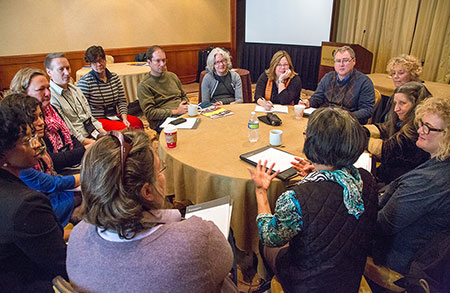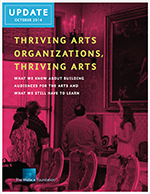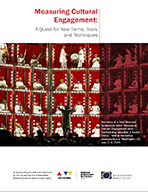January
2015
January 10, 2015
NASAA News and Current Information
NASAA Assembly 2014 Proceedings & Photo Album
Presentations and materials from every learning and peer session of NASAA Assembly 2014 are now available, along with a photo album of memorable moments. The mood was upbeat for the duration of the conference, which took place in New Orleans in November. Staff and council members from state arts agencies across the nation soaked up knowledge in abundant learning sessions, gained understanding in peer sessions covering topics relevant to their daily work, and heard from speakers who stimulated their thinking. Not to mention the fantastic musical performers and visual art venues selected by our host, the Louisiana Office of Cultural Development, who made sure attendees were inspired, too! Check out NASAA Assembly 2014 Proceedings to reminisce over some fabulous photos or to find that presentation you may have missed.
January Report to Councils
NASAA supports state arts agency council members—often a state’s best arts ambassadors—in a number of ways. NASAA Report to Councils is a handy two-pager for these civic leaders that summarizes federal arts actions, provides advocacy assistance, and shares news and useful NASAA research. Keep your council members in the loop: include NASAA’s January Report to Councils in the materials for your next council meeting.
NASAA Web Seminar: Individual Artist Support
What does the landscape look like for individual artist support? On Thursday, January 29, from 3:00 – 4:15 p.m. Eastern, join representatives from a state arts agency, a foundation and an artist service organization for NASAA’s first web seminar in 2015, Individual Artist Support: Trends in Funding and Services. Learn about current trends, challenges and strategies from three experts in the field: Illinois Arts Council Agency Director of Programs Rose Parisi, Surdna Foundation Thriving Cultures Program Director Judilee Reed, and Springboard for the Arts Executive Director Laura Zabel. Registration is free for state arts agency council and staff members.
SAA Leaders: Save the Date for NASAA’s 2015 Leadership Institute
Join us October 7-9 in Salt Lake City, Utah, for the NASAA 2015 Leadership Institute! Created for state arts agency leaders—chairs, council members, executive directors and deputy directors. Ample time is allotted for peer networking, learning sessions designed to sharpen public-service leadership skills, and performances by artists chosen by our host, the Utah Division of Arts & Museums. Save the date now, and look for more news soon.
Grant Funding Initiative Celebrates Arts and National Parks
“Imagine Your Parks” is a new grant initiative created in partnership by the National Endowment for the Arts (NEA) and the National Park Service to celebrate the intersections between the two agencies in honor of the NEA’s 50th anniversary in 2015 and the National Park Service’s centennial in 2016. “Imagine Your Parks” will provide an anticipated $1 million in funding through the NEA Art Works grant category to projects that use the arts to connect people with memorable places and landscapes of the National Park System. Prospective grantees can join a January 21 webinar to learn about Art Works applications and guidelines, including the “Imagine Your Parks” guidelines.
New Issue Brief on State Cultural Districts
As part of the new National Cultural Districts Exchange from Americans for the Arts, NASAA has contributed an issue brief on state cultural district policies, metrics and evaluation. The paper, authored by NASAA Research Director Ryan Stubbs, builds on NASAA’s work on state cultural district policies and practices and gives further insight into cultural districts data collection practices and evaluation challenges. The paper provides an overview of state cultural district policies, describes current data collection practices from state and national perspectives, and outlines recommendations for practitioners looking to collect metrics and evaluate cultural district programs.
The Role of Place in Audience Development
In effort to promote cultural opportunities for all people, The James Irvine Foundation commissioned research on the role of place in facilitating arts engagement. The resulting report, Why “Where”? Because “Who”: Arts Venues, Spaces and Tradition, considers the dynamics between arts programming, spaces to experience it and audience development. It argues that opportunities for creativity should be located in accessible places, even if they are unconventional arts spaces. The report includes 10 case studies as well as a set of recommendations and a framework for applying them in practice.
Two New Audience Development Reports
The Wallace Foundation recently released two new reports on building audiences for the arts. The Road to Results compiles 10 case studies and identifies nine common practices among successful organizations. Thriving Arts Organizations, Thriving Arts summarizes key findings from past research supported by the foundation and also looks at current trends to see what the future might hold for arts audiences.
How the Rural Creative Economy Fared in the Great Recession
How did creative economies in rural areas fare during the Great Recession of 2007-2009? The Economic Research Service of the U.S. Department of Agriculture (USDA) investigates this question in a recent article in its Amber Waves magazine. The article, What Happened to the “‘Creative Class’ Job Growth Engine” during the Recession and Recovery? is based on the USDA’s Creative Class County Codes and on economic data from the Census Bureau’s 2007-2011 American Community Survey. It concludes that rural counties with a strong “creative class” tended to be more resilient following the recession than rural counties without one.
New Report on the Health of Arts Organizations
The National Center for Arts Research (NCAR) at Southern Methodist University has released a second report on the nonprofit arts industry. NCAR examined large data sets from the arts sector to provide data and analysis on revenues, expenses, marketing, engagement, staffing and activities. The report includes both general highlights and in-depth visual exploration of the findings about return on marketing investments, engagement levels by age and more.
Arts Festivals and Intellectual Property Issues
The World Intellectual Property Organization (WIPO), an agency of the United Nations, has published an intellectual property primer for organizers of arts, culture and folk festivals. The guide provides an overview of principles of intellectual property law in relation to the arts and cultural heritage. It also identifies the typical intellectual property challenges of these festivals and summarizes practical strategies for overcoming them. The guide is to serve as a reference and not as a source of legal advice, since every country has its own specific intellectual property laws.
Measuring Cultural Participation: A Survey
In a new report, Measuring Cultural Engagement: A Quest for New Terms, Tools, and Techniques, the National Endowment for the Arts summarizes a June 2014 symposium its Office of Research & Analysis organized in partnership with the Cultural Value Project of the United Kingdom’s Arts & Humanities Research Council. During the symposium, researchers, practitioners and policymakers from the United States, the United Kingdom and other countries examined assumptions, techniques and challenges in measuring cultural engagement. These questions are especially important relative to changes in art forms, demographics and technology.
Annual Forecast for the Social Economy
GrantCraft has released the latest iteration of its annual forecast for the social economy. The report, Philanthropy and the Social Economy: Blueprint 2015, looks at how private capital is used for public good, providing an overview of current major trends. It also points to where there may be important breakthroughs in the social economy in the coming year.
Help Us Start the Year Off Right
NASAA has exciting work on tap for 2015, and we need your help to make it possible! In the coming year, your personal support will help to:
- keep arts leaders informed with federal updates, top-notch research and best practices;
- secure federal resources for states as NASAA represents state arts agency interests in Congress and protects the 40% of the National Endowment for the Arts grants budget designated for states and regions.
Please give today to help all state arts agencies succeed this year. Thank you!
Arizona’s Robert Booker Elected Chairman of Grantmakers in the Arts

Arizona Commission on the Arts Executive Director Robert Booker has been elected chairman of Grantmakers in the Arts (GIA) for the 2015-2016 term. Booker previously served as president of NASAA and as a trustee of Arts Midwest and the Western States Arts Federation. Prior to his work in Arizona, he played many roles at the Minnesota State Arts Board, including eight years of service as executive director. Booker joined the Arizona Commission on the Arts in 2006. A national network of private, public and corporate arts funders, GIA provides leadership and service that advances the use of philanthropic and governmental resources to support the growth of the arts and culture.
In this Issue
State to State
Legislative Update
Announcements and Resources
Executive Director's Column
Research on Demand
SubscribeSubscribe
×
To receive information regarding updates to our newslettter. Please fill out the form below.



